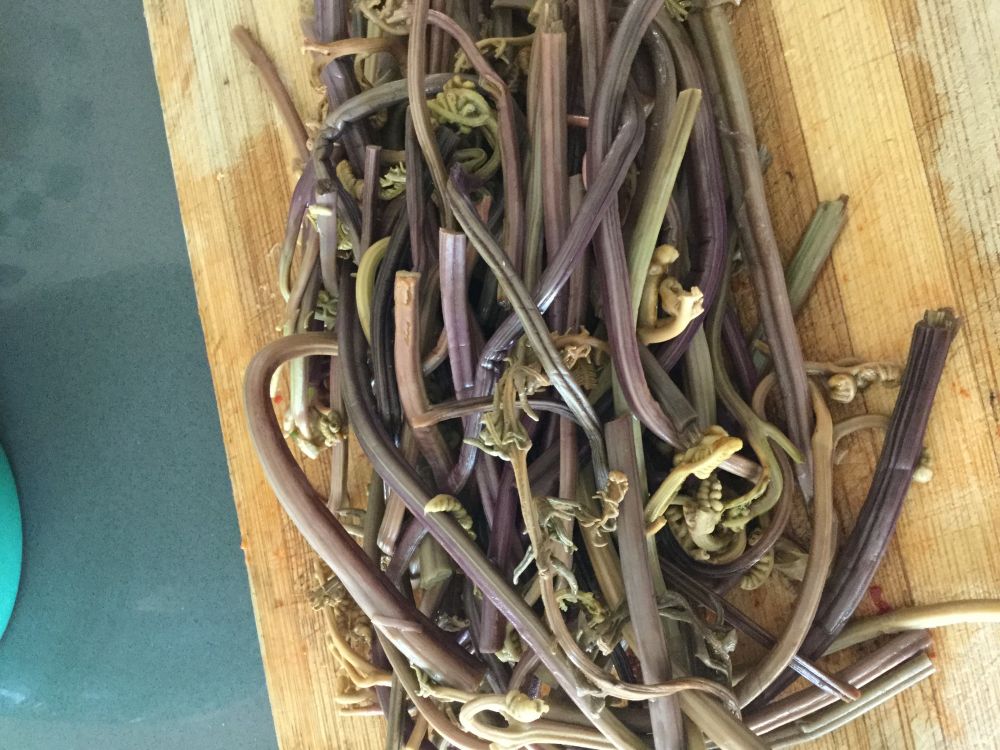2017 (39)
2018 (68)
2019 (88)
2020 (79)
2021 (86)
2022 (83)
2023 (72)
2024 (45)


Sat morning, rucking back from downtown Los Altos, we stopped at the DeMartini
Orchard, a farmers-market style grocery store, and came away awed. It boasted a
few exotic foods, including porcini, morel, and truffles and buffalo milk and
this was the first time we saw fresh fiddleheads in a store, fetching $30/lb.
Just five days ago, I paid four bucks at a nearby Korean store for a 2lb pack
of presoaked fernbrake.
Meanwhile, half a globe away in north-eastern China near the Russian border,
the spring harvest frenzy for wild greens has just drawn to a close and the
crops, including mainly various fiddleheads, are blanched and often dried, and
bagged or vacuum-sealed for shipping. Some might just have come to the Bay
Area and ended up in my fridge.
Until recently, the greens foraged from the ChangBaiShan(长白山)region have mostly
been exported to two eastern Asian neighbors. According to an 80-year-old lady
from the Wanda Mountains, the Japanese came with demand in the 60s. It was said
that the islanders ate bracken fiddleheads (they called it weicai) regularly in
small portions to fend off industrial pollution and radiation. They first bought
the greens fresh and later taught the gatherers how to process them for longer
shelf life. In the days of planned economy, it was an important source of income
for the locals and nearly every family picked. Known as gosari on the Korean
peninsula, the fernbrake is an ingredient of the bibimbap and some of their
banchans. The Chinese first did not like the plant's slightly bitter taste and
worked only for the money but domestic demands have since picked up as the trend
of natural foods overtook the globe.
An article in The Atlantic warned, like liqor, bracken fiddleheads could be
carcinogenic if not properly treated or over-consumed. The author might relax to
enjoy gosari from ethnic food stores, however, if he watched how Asian foragers
first boiled and then soaked the greens in cold water before further processing.
Armed with the background knowledge, I gingerly opened my pack of gosari. The
spears looked recently picked and they sported grayish purple to dark green
colors. The liquid they came in had no smell or taste. I soaked half, cut them
into bite-size pieces, and sauted them in butter. Tender and crunchy, they
reminded me of wilted asparagus. Except for a slight earthiness, they gave
almost no flavor. They didn't even taste bitter.
My experiment was far from over, however, as we finished the dish. Wild greens
are a valuable cultural heritage worth preserving and they will have a place in
my diet.




Wow. In 1985 I was boarding in middle school, learning English under a handsome
teacher who collected stamps. Los Altos must have looked quite different back then.
I remember Reagan as a folksy guy who liked to tell jokes.
Today, every little town around here seems to have a Goodwill.
Thanks for dropping by.
Make-Believe: The Story of Nancy and Ronald Reagan
by Laurence Leamer
at a local Goodwill store.
It is said that fiddleheads can be found in Northern CA (the word "ubiquitous" is even used online though I never saw them here myself.). Since they are ferns family, I guess they might like to grow in the forest or among the shade that provides humidity. The reason I remember seeing in Hawaii is that we took pictures of them, as the curled heads caught our attention.
Hopefully one day you can encounter them in the woods:))
This is something similar to bamboo shoots in the Southern China, a cultural heritage preserved within us. Thanks for sharing and your great post.